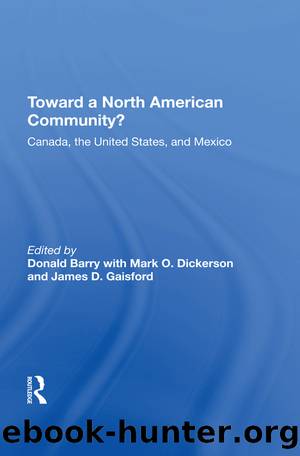Toward a North American Community?: Canada, the United States, and Mexico by Donald Barry

Author:Donald Barry [Barry, Donald]
Language: eng
Format: epub
Tags: Political Science, General
ISBN: 9780367211837
Google: hB-eDwAAQBAJ
Goodreads: 46180105
Publisher: Routledge
Published: 2019-03-05T00:00:00+00:00
Current Problems in Latin American Integration
Despite the widespread enthusiasm for trade liberalization in Latin America, serious obstacles remain. The process of integration has proven extremely difficult for the countries of the Andean Pact, where political unity has always been elusive. They were unable to agree on a CET in early 1993, and Peru abandoned the pact when it was refused special concessions.56 The largest members of the pact, Colombia and Venezuela, seemed to be more interested in negotiating with Mexico than with Ecuador, Peru and Bolivia.
MERCOSUR, like the Andean Pact, faced serious internal obstacles, and it is unclear that it will achieve the ambitious goal of a unified market by 1995.57 MERCOSUR countries were unable to agree on a CET in 1993:58 MERCOSUR countries arrived at agreement on 85 percent of the products they export, however, progress was delayed by Brazilâs refusal to accept a low CET on capital goods.59 Brazil wanted a high external tariff to protect its information sector, while Argentina had no tariff in that sector. Furthermore, the United States and Brazil have a long-standing dispute over computers and patent protection.60 Such conflicts are a major obstacle to MERCOSURâs forming part of a hemispheric free trade agreement.
Economic integration in MERCOSUR has been made more difficult by macroeconomic imbalances. Argentinaâs Economy Minister, Domingo Cavallo, argued that because of an overvalued currency, âunder current conditions Argentina would be very hurtâ by MERCOSUR.61 Heavy inflows of capital into Argentina in the early 1990s raised fears about excessive demand and speculation. Brazil continued to struggle with inflation and macroeconomic instability;62 this forced it to repeatedly adjust its exchange rate, causing friction with Argentina. The completion of MERCOSUR could also be held up by electoral politics. Elections are set for 1994 in Brazil and Uruguay and 1995 in Argentina.
The Brazilian policy establishment reacted with caution to the idea of hemispheric free trade. Brazilâs disputes with the U.S. concern antidumping rules, the Export Enhancement Program, and products subject to the Multifiber Arrangement, none of which were dealt with in the Enterprise for the Americas Initiative. Moreover, hemispheric integration offers no serious debt relief.63 MERCOSUR countries have highly diversified trade links with the rest of the world; thus, linking MERCOSUR to the United States could result in substantial trade diversion, retaliation by trading partners, and high adjustment costs.64
It is not surprising that Brazil proposed the first diplomatic challenge to expanding NAFTA into a Western Hemispheric Free Trade Area (WHFTA). On March 9â10, 1994, foreign ministers from the MERCOSUR countries decided to examine the feasibility of a Brazilian proposal to create a South American Free Trade Area (SAFTA). The proposal would open the doors for accession of other South American countries to the MERCOSUR.
What was the thinking behind the Brazilian proposal? Clearly, some Brazilian officials believe that MERCOSUR should seek to expand and include other countries rather than deepen and converge with NAFTA. The result could be a competition between SAFTA and NAFTA for new members. NAFTA had what one Brazilian official called âthe discrete
Download
This site does not store any files on its server. We only index and link to content provided by other sites. Please contact the content providers to delete copyright contents if any and email us, we'll remove relevant links or contents immediately.
Zero to IPO: Over $1 Trillion of Actionable Advice from the World's Most Successful Entrepreneurs by Frederic Kerrest(4068)
Machine Learning at Scale with H2O by Gregory Keys | David Whiting(3644)
Harry Potter and the Goblet Of Fire by J.K. Rowling(3612)
Never by Ken Follett(3535)
Ogilvy on Advertising by David Ogilvy(3340)
Shadow of Night by Deborah Harkness(3178)
The Man Who Died Twice by Richard Osman(2811)
Book of Life by Deborah Harkness(2723)
My Brilliant Friend by Elena Ferrante(2705)
How Proust Can Change Your Life by Alain De Botton(2617)
0041152001443424520 .pdf by Unknown(2602)
Will by Will Smith(2581)
The Tipping Point by Malcolm Gladwell(2563)
How to Pay Zero Taxes, 2018 by Jeff A. Schnepper(2503)
Purple Hibiscus by Chimamanda Ngozi Adichie(2494)
Hooked: A Dark, Contemporary Romance (Never After Series) by Emily McIntire(2424)
Rationality by Steven Pinker(2151)
Borders by unknow(2119)
Daughter of Smoke and Bone by Laini Taylor(2083)
